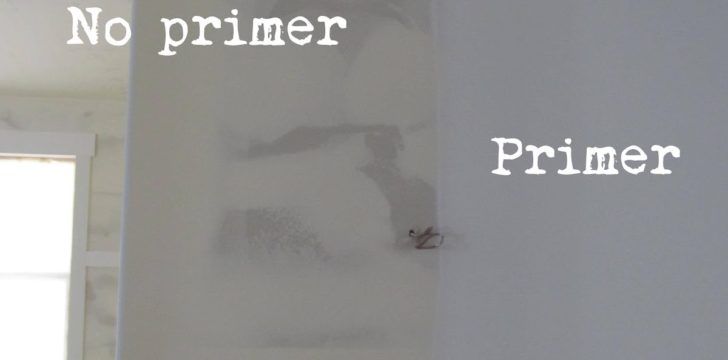Knowing how many coats of primer you should use on new drywall can be a little confusing, especially if you don’t even understand the importance of primer. In fact, many homeowners neglect to apply primer before they paint over their new drywall. This is a big mistake that usually results in a bad-looking paint job. Before we get into the number of coats you should be using, it’s important to have a good understanding of what primer is.
What is primer, and why is it important?
In order to appreciate the effectiveness of primer, you’ll need to understand porosity. Porosity defined here is the surface’s ability to soak up paint. Both the drywall mudding and the face paper on your finished drywall have different levels of porosity. As a result, each one will soak up a different amount of paint, because they each have different porosity levels.

What does this all mean? Neglecting to add a layer of primer will more than likely end up with a sheen here and there. These are not only noticeable, but they’re also quite tacky too. However, by simply adding a layer of primer, the whole surface will have the same porosity level and will soak up the paint at an even rate. The result is a gorgeous surface.
In addition to sheens, painting on new drywall that hasn’t been primed can also cause your paint to bleed through, crack, peel when dried, and even become yellowish in color. Instead of trying to save both time and money by skipping the primer, paint your drywall right. You won’t be disappointed in the long run. Just remember, the idea is to get your porosity level so it’s uniform throughout the whole surface, and the primer does exactly that.
So, how does primer specifically work? The main chemical in primer is polyvinyl acetate (PVA). Once you apply primer, the PVA in the substance goes to work by sealing all of the porous surfaces in the drywall mudding and the wall paper while also making them more receptive to fresh paint as well. PVA also makes primer stick to new drywall better than paint. Furthermore, paint sticks to primer much better than it does to the drywall itself.
High-solid primer, self-priming paint, and tinted primer
If you don’t know what self-priming paint is, it’s paint with the primer already added. Self-priming paint not only contains the component PVA, there’s also several solids. This allows the painter to build a finish in two coats or less. Tinted primers on the other hand are often added to high-solid primers to work in the same way as self-priming paint.
Although self-priming paint and tinted primers are useful, always use a high-solid primer when you plan to paint over stained drywall or drywall that’s suffered water damage. High-solid primers are best used to help eliminate bleeding and uneven coloring. If you plan on wall papering your surfaces, then a high-solid primer is definitely your best choice.
How much primer do I need for new drywall?
Now that you know what primers are, what they’re used for, and the different kinds available, you need to know how many coats of primer are needed on new drywall. Typically, if you’re using a traditional or high-solid primer, you only need one coat.
However, you’ll want to inspect the surface once it’s dry. This is the best way to tell if you need another coat. Inspect the color, whether it’s smooth or not, the overall texture, how the paint absorbed, and look for surface contamination. If everything looks good, then you’ll get by with one coat. On the other hand, if any of your inspections don’t look satisfactory, you may need to add another coat of primer.
If you’re using self-priming paint, you’ll usually give your surfaces two to three coats. Remember, this is a primer and paint mixture. You’re priming and painting your surfaces at the same time. For the tinted primer, when added to high-solid primers, you only really need to apply one coat. That’s it.
How to prime your drywall
You know what primer is and how many coats you will need to apply. The next step is to go ahead and get the job done. To prime your new drywall, you’ll want to:
- Fix any cracks in the walls before you prime your surfaces.
- Apply your first coat of primer. Use even strokes and make sure you cover the whole surface.
- Let your surface dry. Most primers are designed to dry fast.
- Inspect the surface. If it looks good, you can start to paint. However, if the surface doesn’t pass inspection, you may need to add another coat.
- Painting Over Powder Coat and What You Need to Know - February 1, 2022
- How to Get Rid of Humidity in a Basement Without a Dehumidifier - December 17, 2021
- How to Fix a Crack in Drywall That Keeps Coming Back - September 22, 2021

PJ
Thursday 30th of December 2021
On new construction homes, I spray all walls and ceilings with flat white paint and back roll with an 18" roller. That's with 2 coats on the ceilings and 1 coat on the walls 🤙